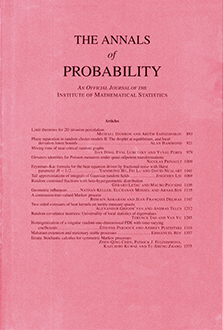Abstract
We study the following microscopic model of infection or epidemic reaction: red and blue particles perform independent nearest-neighbor continuous-time symmetric random walks on the integer lattice $\mathbb{Z}$ with jump rates $D_{R}$ for red particles and $D_{B}$ for blue particles, the interaction rule being that blue particles turn red upon contact with a red particle. The initial condition consists of i.i.d. Poisson particle numbers at each site, with particles at the left of the origin being red, while particles at the right of the origin are blue. We are interested in the dynamics of the front, defined as the rightmost position of a red particle. For the case $D_{R}=D_{B}$, Kesten and Sidoravicius established that the front moves ballistically, and more precisely that it satisfies a law of large numbers. Their proof is based on a multi-scale renormalization technique, combined with approximate sub-additivity arguments. In this paper, we build a renewal structure for the front propagation process, and as a corollary we obtain a central limit theorem for the front when $D_{R}=D_{B}$. Moreover, this result can be extended to the case where $D_{R}>D_{B}$, up to modifying the dynamics so that blue particles turn red upon contact with a site that has previously been occupied by a red particle. Our approach extends the renewal structure approach developed by Comets, Quastel and Ramírez for the so-called frog model, which corresponds to the $D_{B}=0$ case.
Citation
Jean Bérard. Alejandro Ramírez. "Fluctuations of the front in a one-dimensional model for the spread of an infection." Ann. Probab. 44 (4) 2770 - 2816, July 2016. https://doi.org/10.1214/15-AOP1034
Information





